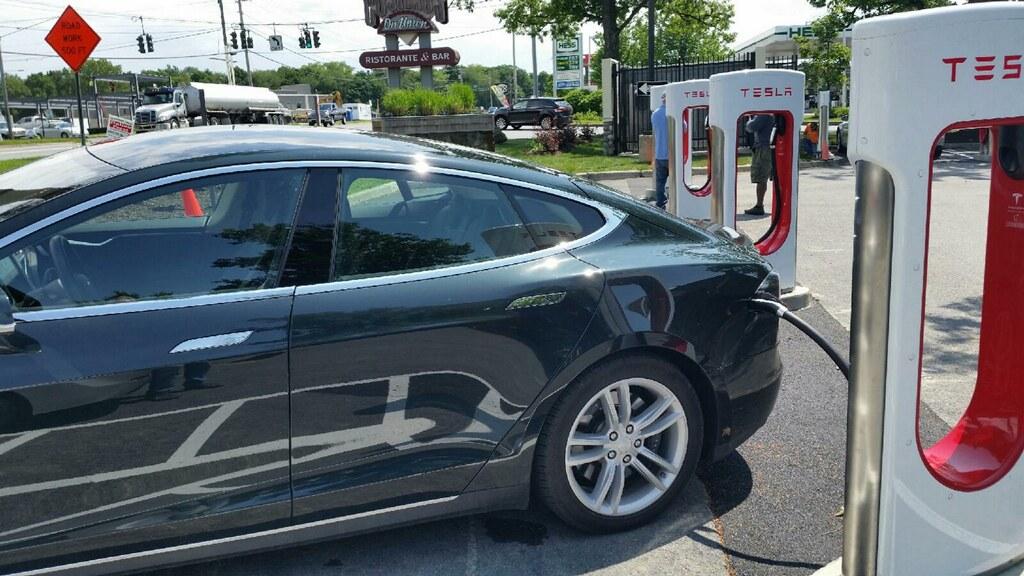Tesla is the world's only automaker to build and operate its own large-scale network of public charging stations.
This year, the Silicon Valley automaker hopes to double the number of Supercharger DC fast-charging sites, to make it more convenient for U.S. Tesla owners to undertake longer road trips.
With 373 sites in the U.S., Canada, and Mexico today, offering 2,636 charging cables, Tesla's fast-charging locations still aren't particularly common.
DON'T MISS: Tesla plans major U.S. expansion of Supercharger fast-charging
If Tesla wanted to make fast-charging its cars as convenient as going to a gas station, says UBS analyst Colin Langan in a new report (via CNBC), it would have to spend nearly $8 billion more in the U.S. alone.
Based on geospatial imaging of the U.S., the UBS analysis estimated that the current average drive time to a Tesla Supercharger station is around 30 minutes, compared to an average of 4 minutes for the nearest gas stations.
To close that gap, Tesla would need to add around 30,000 new individual charging stations, Langan said.

Tesla Supercharger site in Newburgh, New York, up and running - June 2015
Whether having a Supercharger site just four minutes away is even necessary to provide the necessary level of security for Tesla drivers on long-distance trips is a completely different question, of course.
Still, Langan suggests, investing the necessary sum to build so many additional stations would likely be met with concern from Tesla investors already nervous about the automaker's capital expenditures.
Tesla could spend up to $35 billion in capital expenditures through 2025, Langan said—including the $8 billion to make Supercharger stations as common as gas stations.
ALSO SEE: Tesla releases Supercharger electric-car fast-charge prices
The $35 billion figure is mostly comprised of anticipated investments needed to ramp up Model 3 production to the company's goal of hundreds of thousands a year, complete planned expansions of Tesla's Nevada battery "Gigafactory" and similar plants in additional locations, and other costs.
Charging stations that were as common as gas stations might improve the public perception of electric cars by decreasing range anxiety, but Tesla CEO Elon Musk has indicated he doesn't think so many stations are necessary.
It becomes "really unwieldy for people to use the gas-station approach for electric cars," Musk said at a November 2016 investor meeting, adding that "cars should really be charged where you charge your phone."

Quick Check convenience store with Tesla Superchargers under construction, Kingston, New York
Indeed, data shows that most electric-car drivers today rely primarily on home charging for daily commuting and shorter trips. That's impossible with gasoline.
Still, only 47 percent of U.S. drivers have dedicated parking that can accommodate charging, UBS' Langan told CNBC. The percentages for Europe and China are lower yet, he noted.
Tesla has consistently emphasized that its public charging network is intended to support long trips.
CHECK OUT: Musk ups Tesla Supercharger ante, teases 350-kw-plus charging (Dec 2016)
It gently encourages customers not to use Supercharger sites for local driving, and it has installed thousands of 240-volt Level 2 AC "Destination Chargers" at locations its buyers are likely to visit for longer periods, including restaurants and luxury hotels.
As deliveries of the the mass-market Model 3 electric car begin, Tesla may find its customers using their electric cars in a wider variety of ways.
Whether that requires a reassessment of its charging-network strategy will be one of the issues the company's followers watch when the Model 3 rolls out.
[hat tip: Robert]
_______________________________________________











